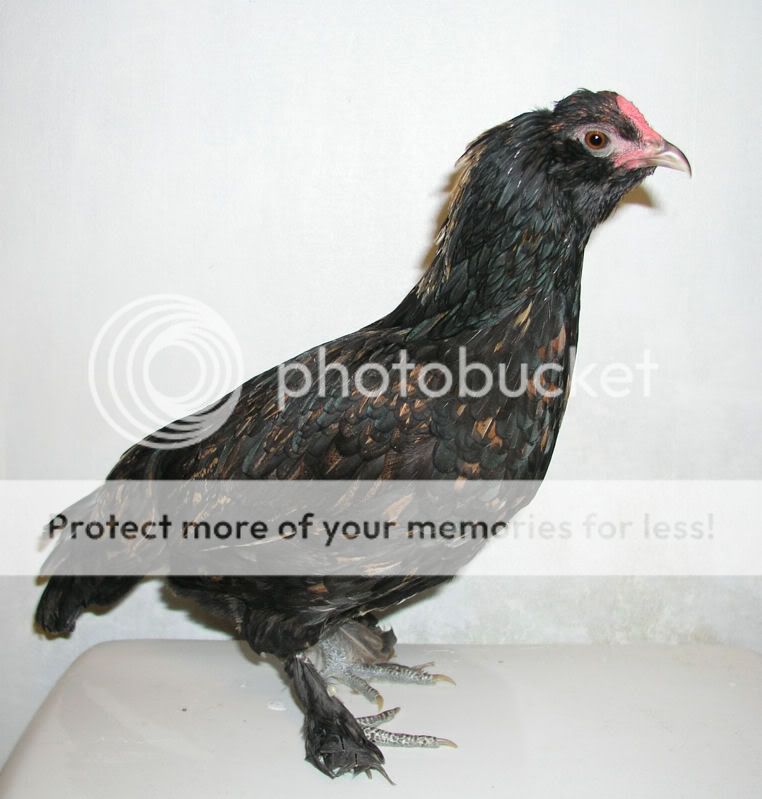Quote:
Paul,
Normally every somatic cell (body cell) in a mammal is genetically male or female; this excludes sex cells. The xx chromosomes and xy chromosomes determine the primary sex characteristics (genetalia) found in a mammal. It is the secondary sex characteristics that are determined by sex hormones. The same is true in the chickens somatic cells; female cells are normally genetically ZW and male cells are ZZ. In chickens, the presence of female hormones cause female feathering and the lack of female hormones cause male feathering.
Your bird appears to be 100% female. It does not have male feathering on one side and female feathering on the other. If the female layed an egg that means it has a functional overy ( normally chickens have only a functional left ovary) which would prevent the male feathering on one side. You would have to analyze ( do a karyotype) the chromosomes on both sides to detemine if one side is male an the other is female.
Tim
Tim, thank you for taking the time to explain this to me. This is all new to me and I am still learning. The photos were taken last October when the bird was three months old. This was before before it had molted to its adult plumage and matured sexually. I think your theory that it is a gynandromorph with a functional ovary is correct since its comb reddened up when it was just 3-4 weeks old. It looked and acted more like a cockerel, with a large bright red comb, until about a month ago. there are no recorded examples of the changes that occur during the development from a young bird to an adult. These birds may go through a number of changes although few have functioning ovaries. It is only 4-1/2 months old.
Paul,
I did some research and I have found a paper that deals with sex determination in birds and mammals. The paper is co-authored by some of the scientists at Edinburgh. After the egg is fertilized in mammals, each cell that develops from the fertilized egg is sex neutral and can not be identiifed as male or female. In birds, after the egg is fertilized the cells that develop from the fertilized egg will have a male identity or a female identity. The male cells have a different molecular mechanism in them than the females. The mechanism determines if the cells are female or male. I need to sit down and analyze the paper and get a better grasp on the idea.
Tim
Paul,
Normally every somatic cell (body cell) in a mammal is genetically male or female; this excludes sex cells. The xx chromosomes and xy chromosomes determine the primary sex characteristics (genetalia) found in a mammal. It is the secondary sex characteristics that are determined by sex hormones. The same is true in the chickens somatic cells; female cells are normally genetically ZW and male cells are ZZ. In chickens, the presence of female hormones cause female feathering and the lack of female hormones cause male feathering.
Your bird appears to be 100% female. It does not have male feathering on one side and female feathering on the other. If the female layed an egg that means it has a functional overy ( normally chickens have only a functional left ovary) which would prevent the male feathering on one side. You would have to analyze ( do a karyotype) the chromosomes on both sides to detemine if one side is male an the other is female.
Tim
Tim, thank you for taking the time to explain this to me. This is all new to me and I am still learning. The photos were taken last October when the bird was three months old. This was before before it had molted to its adult plumage and matured sexually. I think your theory that it is a gynandromorph with a functional ovary is correct since its comb reddened up when it was just 3-4 weeks old. It looked and acted more like a cockerel, with a large bright red comb, until about a month ago. there are no recorded examples of the changes that occur during the development from a young bird to an adult. These birds may go through a number of changes although few have functioning ovaries. It is only 4-1/2 months old.
Paul,
I did some research and I have found a paper that deals with sex determination in birds and mammals. The paper is co-authored by some of the scientists at Edinburgh. After the egg is fertilized in mammals, each cell that develops from the fertilized egg is sex neutral and can not be identiifed as male or female. In birds, after the egg is fertilized the cells that develop from the fertilized egg will have a male identity or a female identity. The male cells have a different molecular mechanism in them than the females. The mechanism determines if the cells are female or male. I need to sit down and analyze the paper and get a better grasp on the idea.
Tim




